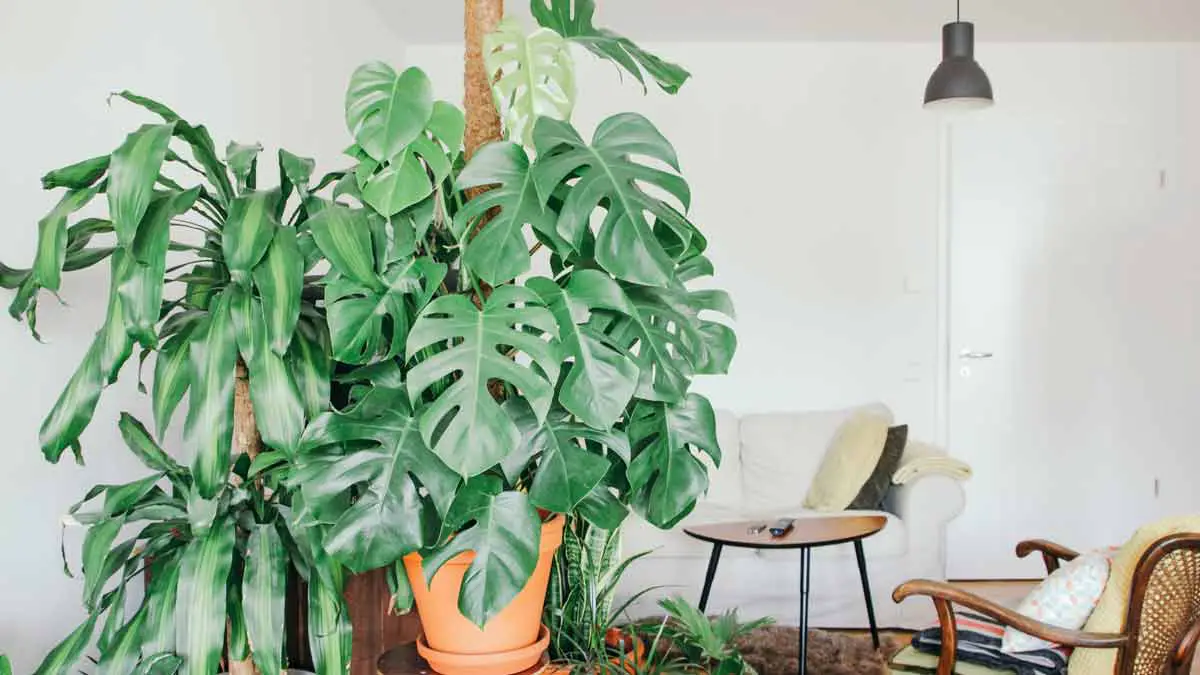Staking Monstera plants provides benefits such as preventing stem bending and promoting upright growth. Insert a tall, sturdy stake into the pot at the plant’s base, or use bamboo stakes or poles with mesh and sphagnum moss to support the plant. Stake when the plant leans, or its stems droop.
Monstera plants, the Swiss cheese plant, are a popular houseplant known for their lush and vibrant foliage.
These tropical beauties can grow quite large and must be staked to keep them healthy and promote strong growth.
Staking your Monstera helps the plant maintain its shape, prevents it from leaning or toppling over, and allows you to train the vines in any direction that you want.
In this article, we’ll discuss how to stake a Monstera plant properly and some of the benefits of doing so.
Benefits of Staking Monstera Plants
The Monstera plant is a stunning foliage plant that comes in many varieties. If you’ve seen pictures of leaves with holes that look like Swiss cheese, then you’re looking at a Monstera!
Staking this plant type is very beneficial for helping it reach its full potential.
Some of the main benefits of staking a Monstera plant are:
1. Promotes Upright Growth and Balance
One of the main benefits of staking your Monstera plant is that it promotes upright growth and balance.
As your plant grows taller, it may become top-heavy and start to lean to one side.
You can encourage your Monstera to grow straight up and maintain its balance by providing a stake or support structure.
2. Prevents Stem Bending and Breakage
Another benefit of staking your Monstera plant is that it prevents stem bending and breakage.
Monstera plants have thick stems that can become heavy as they grow taller.
Without proper support, these stems may bend or break under their weight.
By staking your Monstera, you can prevent this from happening and ensure that your plant stays healthy and strong.
3. Increases Leaf Size and Fenestration
Staking your Monstera plant can also increase leaf size and fenestration.
Fenestration refers to the natural holes or “windows” in the leaves of some Monstera plants.
When you stake your plant, it encourages the growth of new leaves along the stem, which can be larger and more fenestrated than those lower down on the stem. This is because the staking helps the plant to stand upright and grow towards the light.
4. Provides Extra Humidity and Nutrients via Aerial Roots
Staking your Monstera plant provides extra humidity and nutrients via aerial roots.
These roots are naturally designed to attach themselves to trees in the wild, where they absorb moisture and nutrients from the air around them.
By providing a stake or support structure for your Monstera aerial roots to cling onto, you’re creating a mini ecosystem that can help keep your plant healthy and thriving.
5. Gives Your Monstera Room to Flourish
Finally, staking your Monstera plant gives it room to flourish.
Rather than growing outwards and becoming overcrowded, the stake provides a space for the plant to grow upwards, enabling its stems and leaves to reach their full potential.
This also increases airflow around the plant, helping to prevent fungal diseases and pest infestations.
Overall, staking your Monstera plant is a great way to help ensure that it stays healthy and looks its absolute best.
With the right support structure in place, you can help your Monstera reach its full potential and enjoy all the wonderful benefits that come with
Signs That Indicate Staking Is Needed
Monstera plants are known for their large, beautiful leaves and unique appearance. However, as they grow, they may require additional support to maintain their upright position.
Here are some signs that indicate staking is needed for your Monstera plant:
1. Bent Stems
If you notice that the stems of your Monstera plant are bending toward the floor, it could be a sign that it needs extra support.
This can happen when the plant becomes top-heavy or does not receive enough light. The lack of support can cause the stems to become weak and bend toward the ground.
2. Leaning Plant
Another sign that your Monstera plant needs staking is if it is growing sideways.
This can happen when the plant is growing towards a light source or when it is not getting enough support from its roots.
You may also notice the stem becoming weak and sagging at one end.
3. Falling Leaves
If you notice that the leaves of your Monstera plant are falling off, it could be a sign that the plant is not getting enough support from its stem.
This can happen when the stem becomes weak and cannot hold up the weight of the leaves.
Falling leaves can be caused by stress on the stem or lack of support for the growing foliage.
Adding a stake or support structure can help alleviate this stress and keep your leaves healthy and attached.
4. Long Internodes
Long internodes refer to the space between leaves on a stem of a Monstera plant.
If these spaces are too long, it can cause the stem to become weak and floppy over time. This can lead to bending or even breaking the stem without proper support.
Providing a stake for your Monstera plant can help ensure that the internodes remain short and the stem stays upright.
5. Aerial Roots Showing
if you notice aerial roots showing on your Monstera plant, it’s time to consider staking it up!
The Monstera plant, in nature, uses these roots to attach themselves to trees in search of nutrients and moisture from the surrounding air and soil.
But when grown indoors, they need some sort of support structure like stakes, so they don’t grow out too far away from their natural habitat.
Adding a stake to your Monstera plant is a great way to help these aerial roots stay put and provide the plant with extra nutrition.
By providing the right support structure for your Monstera, you can ensure that it stays healthy and looks its best!
Choosing the Right Stake for Your Monstera Plant
Choosing the right stake is important for your Monstera plant. The stake should be strong enough to hold the weight of the plant but not so large that it takes up too much space in your home.
Some common types of stakes that are suitable for Monstera plants include:
1. Bamboo Stakes
Bamboo stakes are popular for staking Monstera plants due to their affordability and versatility.
They come in various sizes and lengths, making them suitable for plants of different heights.
Bamboo is also a renewable resource that’s environmentally friendly and easily available.
Advantages:
- Affordable
- Versatile
- Renewable resource
- Environmentally friendly
2. Coco Coir or Sphagnum Moss Poles
Coco coir or sphagnum moss poles are other popular choices for staking Monstera plants.
They come in various sizes and lengths, making them suitable for plants of different heights.
These poles are made from natural materials that can help retain moisture around the aerial roots, providing additional humidity and nutrients for your plant.
Coir and moss poles are also very durable and long-lasting, so they won’t need to be replaced too often.
Advantages:
- Retains moisture around aerial roots
- Provides additional humidity and nutrients
- Durable and long-lasting
3. Metal Stakes
Metal stakes are another great option for staking Monstera plants. These stakes are very strong, making them ideal for supporting heavier plants.
They also come in various sizes, so you can easily find one that fits your Monstera plant.
Advantages:
- Strong and durable
- Ideal for heavier plants
- Available in various sizes
4. Wooden Stakes
Wooden stakes are another option for staking your Monstera plant.
They’re sturdy and provide excellent support for heavy foliage.
They come in various sizes and shapes, allowing you to choose one that fits your plant’s needs.
A wooden stake can be reused multiple times and can be easily customized by painting or staining it.
However, they may not be as durable as other types of stakes, especially if they’re exposed to moisture regularly.
Advantages:
- Sturdy and provides excellent plant support
- Inexpensive compared to other stakes.
5. Wire Mesh Stakes
Wire mesh stakes are a great choice for Monstera plants as they provide good support without the risk of damaging the roots or stems.
The wire mesh is also flexible, so it can be easily adjusted to fit your plant’s size and shape.
These stakes are lightweight and easy to use, making them a great choice for those who want an easy and hassle-free way to provide their Monstera plants with extra support.
Advantages:
- Flexible
- Lightweight
- Easy to use and adjust
- No risk of damaging the roots or stems.
When choosing a stake for your Monstera plant, consider factors such as height, weight, durability, cost-effectiveness, environmental impact, etc., depending on what matters most to you personally.
How To Stake a Monstera Plant
Once you’ve chosen the right type of stake for your Monstera plant, it’s time to get staking!
Here are some easy steps to follow when staking your Monstera:
Step 1: Calculating the Height of the Stake Needed
Before you start staking your Monstera plant, you need to determine how tall your stake should be.
The stake should be at least one-third the height of the plant, but it can be taller if needed.
You want to make sure that the stake is tall enough to support the entire plant as it grows.
Step 2: Inserting the Stake into the Soil
Once you have determined the height of your stake, it’s time to insert it into the pot.
Choose a sturdy stake that is taller than your Monstera plant and insert it into the soil at the base of the plant.
Make sure that it is firmly planted in the soil and won’t wobble or tip over.
Make sure to leave enough room around the plant stake so that the roots will be able to spread out and get enough nutrients.
Step 3: Firming Soil Around Pole
Once you have inserted the stake into the soil, it’s time to firm up the soil around the pole.
Use a trowel or your hands to firmly pack down the soil around the base of your stake.
This will help keep it in place and secure.
Step 4: Securing Monstera Plant to Stake
Once the stake is firmly in place, gently tie your Monstera vines to it using soft plant ties or fabric strips.
Be careful not to tie them too tightly as this could damage or cut off circulation in your plants.
You should be able to adjust the ties as your plant grows, so make sure they are not too tight.
Make sure to double-check your work and ensure that all of the vines have been securely tied to the stake.
Step 5: Guiding Aerial Roots Toward Pole
Monstera plants have aerial roots which grow downwards from the stems.
When staking your Monstera plant, you should gently guide these aerial roots towards the stake so they can attach themselves to it and get the support they need while growing.
Step 6: Supporting New Growth
Your Monstera plant may produce new leaves, shoots, and stems over time.
You should ensure that these new growths are supported by the stake and the existing vines and aerial roots.
To do this, you can simply adjust the ties or add additional support for the new elements of your plant.
Methods of Staking Monstera Plants
There are several methods of staking Monstera plants, each with its own benefits and drawbacks. Your choice of staking method will depend on your personal preferences and the size, growth patterns, and needs of your Monstera plant.
The most common staking methods are:
Single Straight Stake Method
The single straight stake method is the simplest way to stake a Monstera plant.
It involves inserting a single stake into the soil near the base of the plant and tying the stem to the stake with a soft tie or twine.
This method is best for smaller plants or those with only a few stems.
Pros:
- Easy to set up
- Inexpensive
- Can be used for small plants
Cons:
- Not suitable for larger plants
- May not provide enough support for heavy stems
Bamboo Stake Method
The bamboo stake method involves using multiple bamboo stakes to create a support structure around the Monstera plant.
The stakes are inserted into the soil around the perimeter of the plant and tied together at the top with twine or wire.
This method is best for larger plants or those with multiple stems.
Pros:
- Provides more support than the single straight stake method
- Can be customized to fit any size plant
- Inexpensive
Cons:
- Requires more setup time than single straight stake method
- May not be as aesthetically pleasing as other methods
Pole with Mesh and Sphagnum Moss Method
The pole with mesh and sphagnum moss method is a popular way to support Monstera plants while also promoting aerial root growth.
A moss-covered pole is inserted into the soil near the base of the plant, and then mesh, or twine is wrapped around both the pole and stem of the plant, securing it in place.
This method is ideal for larger plants with multiple stems but can also be used on smaller plants.
Pros:
- Provides excellent support for heavy stems
- Promotes aerial root growth
- Aesthetically pleasing
Cons:
- More expensive than other methods
- Requires more setup time
- May not be suitable for smaller plants
No matter which staking method you choose for your Monstera plant, make sure that everything is securely in place before leaving it alone.
If you find that the stake or ties are not providing adequate support, don’t hesitate to adjust them or add additional support to ensure your Monstera’s safety and growth.
Tips for Training Monstera Plants Around a Support Stake
Aside from staking, training your Monstera plant around a support stake will help it to grow in the desired shape.
Here are some tips for training your Monstera plant:
- Use gentle pressure when tying vines and aerial roots to the stake—you don’t want them to be too tight.
- Adjust the ties or stakes as needed to keep your Monstera plant’s shape under control.
- Make sure that all the vines and aerial roots get adequate support from the stake.
- Let older Monstera plants climb freely—you don’t want to stunt their growth.
- Moisten the stake and ties regularly so aerial roots can attach to the stake.
- Add an extension to the stake if your Monstera has outgrown the original stake.
- Rotate your plant regularly, so all sides get equal sun exposure.
- Prune off any dead leaves or stems to keep your Monstera healthy and encourage new growth.
Staking and training your Monstera plant is an important part of its care. By following these simple tips, you can make sure your Monstera is healthy and growing the way you want it to!
Final Thoughts
Staking a monstera is an inexpensive and easy way to train the plant to take up less room.
It takes patience, but with the right setup and knowledge, it’s possible to keep your monstera thriving in any space.
Whether you want your indoor jungle to grow freely or you’d prefer a classic look for your plant, staking your monstera is a great way to achieve any style.
Watching your plant’s progress after all your hard work is super satisfying!
So go ahead and get staking – you won’t regret it!







